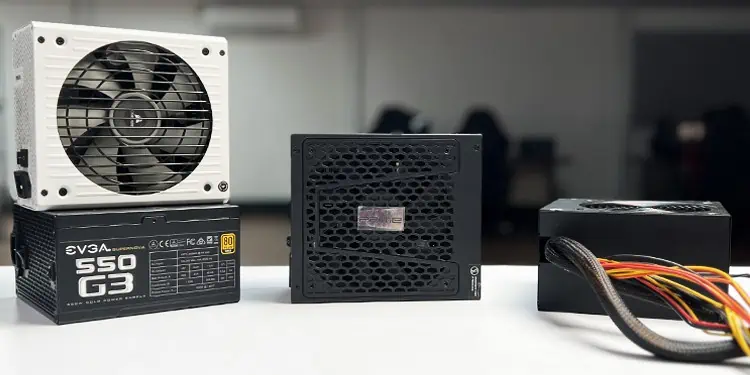Choosing a right power supply unit is just as important as any other hardware component for your build. If you are not using the right one, things may not turn out well—it doesn’t matter how top-notch other components are.
During my builds, I often prioritize PSU wattage over anything else. As a rule of thumb, I always keep a headroom of 25% to 30%, that not only ensures stable performance but also facilitates future upgrades and overclocking.
To know which power supply to choose, first find out the power requirement of your system. Then, figure out the PSU wattage. Next, choose the correct size PSU that fits into the PSU compartment. The rest of the things, like modularity and efficiency ratings, are completely your preference.
Here’s a step-by-step breakdown to help you choose the right power supply unit for your build.
Calculate Your System’s Power Needs
PSU wattage is always the first thing to consider whenever you are choosing a power supply. If I am not wrong, I think you have already planned what components you will be using with your setup. In fact, you might have already purchased a few of them.
Now what you need to do is, go to online power supply calculator sites like PCPartPicker and figure out the power requirements of your system.
Personally, when I calculated the power needs for my last build, it came out to be 450 watts. But wait! Does this mean I get a 450-watt PSU, then? No, it doesn’t.
Leave Sufficient Wattage Headroom
As discussed above, while my power requirement was only 450 watts, I opted for a 650W PSU instead. It was enough for me, even if I wanted to overclock or add components in the future.
Do note that you should always keep adequate wattage headroom while you are getting a PSU. Normally, it is ideal to keep a headroom of about 30%.
Understand the 80 PLUS Efficiency Ratings
80 PLUS is a widely used term when it comes to the efficiency rating of a PSU. You might have seen labels on a PSU like 80 PLUS Silver, 80 PLUS Gold or Platinum. The higher the rating, the more efficient the power supply.
Let me quickly clarify this with the help of an example. For instance, below is my 80 PLUS Gold certified EVGA SuperNova 550 G3 PSU.
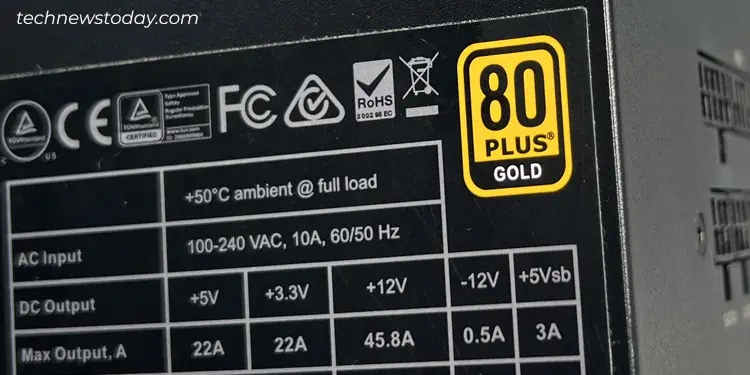
The rating indicates that this PSU will yield 87% efficiency while running at 100% load. To be more precise, the PSU will take 575 watts from the wall outlet to supply 550 watts to your PC. The rest of the energy would be dissipated as heat.
So, it is always better to choose a high-efficiency PSU to save energy as well as reduce your electricity bill.
Choose the Right Size PSU
Often referred to as form factor, physical size is also an important consideration when choosing a power supply. There are mainly two form factors of a PSU that rule the market today—SFX and ATX.
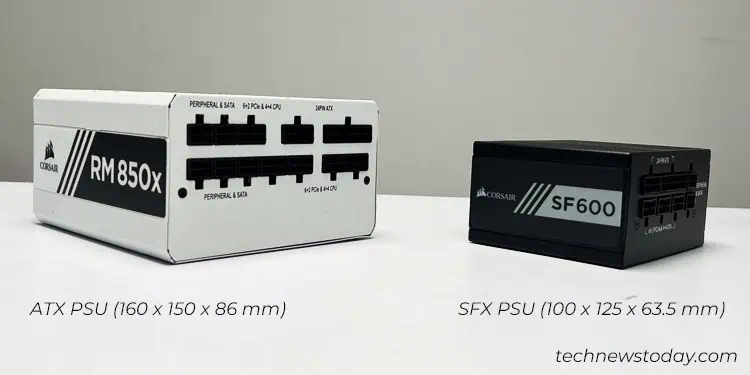
As you can see in the image, the larger one is the ATX form factor, and the smaller one is the SFX one. Your choice completely depends on what type of PC case you have. Simply check the specifications of your PC case and see if it fits an ATX PSU or an SFX PSU.
Picking the Right Modularity
When it comes to modularity, it all depends on your personal preference. You may either opt for a non modular, semi modular or a fully modular PSU.
While the modular ones allow you to unplug every cable, non-modular ones do not allow you to do this. On the other hand, the semi-modular ones, as the name suggests, allow partial detaching of cables.
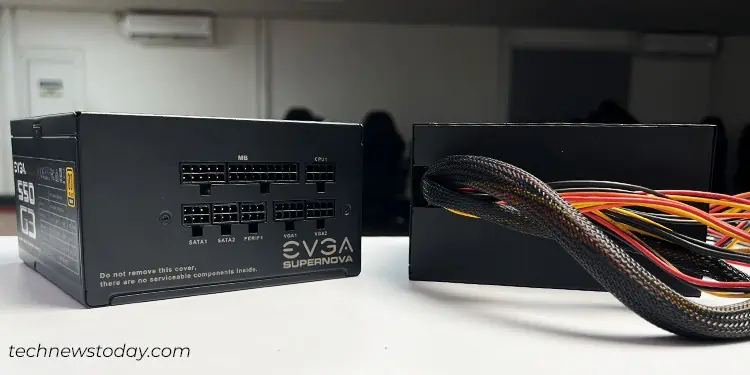
To be honest, semi-modular is what I prefer personally for my builds. They are priced between the rest of the two and also make cable management easier up to some extent.
Check the Connector Compatibility
Thanks to Intel, all the power supplies today follow the ATX standard pinout, making the same PSU compatible across all kinds of setups. Having said that, it is still crucial to check the connector compatibility while choosing a PSU. Let me explain it to you.
While the 24-pin ATX power connector and the 8-pin CPU connector are the standard ones to power up your motherboard and CPU, the pinout of your GPU can make a significant difference.
Depending upon the power requirement, your GPU may either have a 6, 8, 12, 16 or even 24-pin connector. Let’s suppose it has a 16-pin PCIe 5.0 connector. You can’t power it up using any low-end or mid-range PSUs. You need a special PCIe 5.0 compatible power supply in such cases.
So, it is a must to check the power supply connector configuration of all the PC components before getting a power supply.
On the other hand, the number of cable connectors also makes a difference. Say, you require multiple power cables for your SATA drives or PCIe cable for the GPUs. You should make sure the PSU comes with the required number of these connectors. Multiple cable connectors will also be helpful if you are into overclocking.
Similarly, if available, you may also choose the color of the PSU. They are mostly available in black or white color, focusing the needs for all-white-build or all-black build.
Look for Protection Features
When it comes to the protection of power supply, manufacturers nowadays incorporate several technologies like OverCurrentProtection, OverVoltageProtection, OverTemperatureProtection, ShortCircuitProtection and more. These protection features are highly recommended to save your overall system at the time of catastrophic failure.
Quickly check the PSU specs to see if these features are available. Here’s my EVGA SuperNova 550 G3 PSU that comes with all these protection.
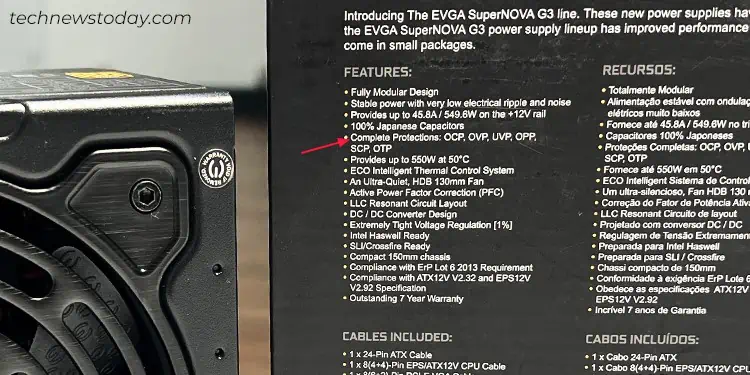
Choose Quiet Fans
I am pretty sure nobody wants the distraction of a buzzing or humming sound while working. That’s why I always suggest getting a PSU that has a hybrid fan mode or semi-passive fan mode that lets the PSU fan rotate only after a certain load/temperature limit. It allows complete silent operation during low to medium loads. Not to mention, it enhances the lifespan of the PSU, too!
Similarly, talking about the fan size, consider getting a PSU that has a larger fan in its form factor range. For instance, my ATX EVGA 550 G3 has 130mm fans that are ultra-quiet.
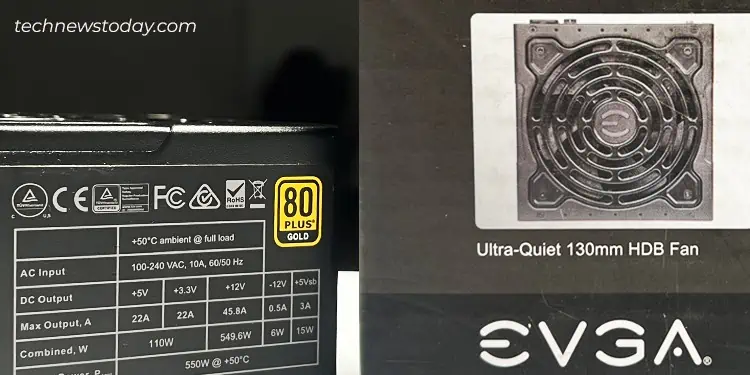
Larger fans are always a good choice since they can move the same amount of air as the small-size fan but at a low RPM, ultimately making them silent.
Opt for a Reputable Brand
It’s always a better idea to invest in a branded PSU from a reputable manufacturer than from a cheap, untrustworthy brand and regret it later.
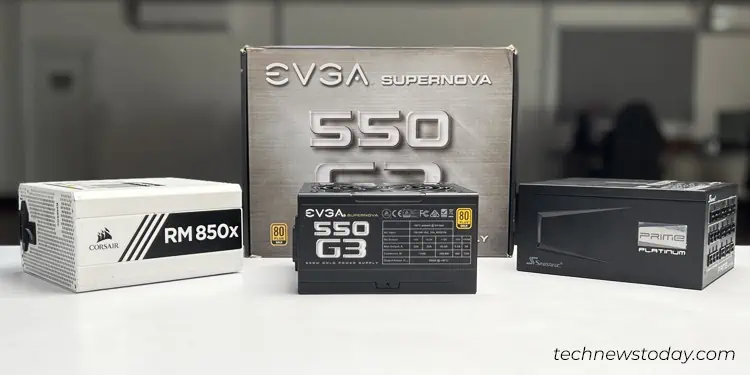
Personally, I prefer Corsair, Be Quiet, Seasonic, EVGA, and Thermaltake, which supply top-notch PSUs across the globe.
They are far more reliable than other manufacturers and have an outstanding build quality. Not only do these PSUs last longer, but they also have good policies for repair, return, and refund in case of failure.
Pick PSU With a Higher Warranty Period
Another thing to consider while purchasing a PSU is its warranty period. I suggest you get a PSU that has a warranty of anything between 5 to 10 years.
A higher warranty period indicates the confidence of the manufacturer that the PSU won’t fail. Believe me; you can rely on those PSUs completely.
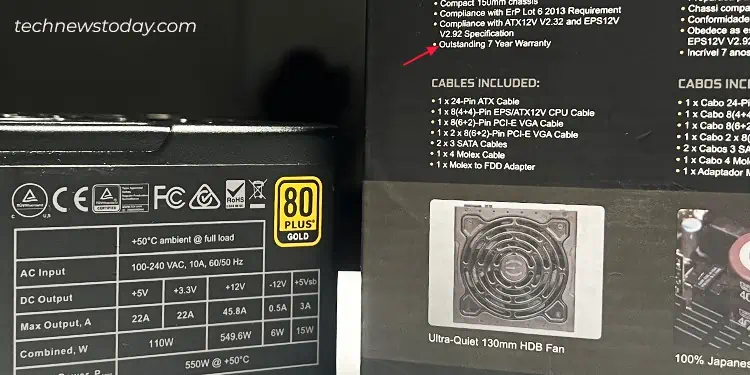
PSU warranty gets void only if you remove its chassis, which is something that a normal user would not opt for. Even when the fan gets damaged, you’ll have to replace the entire unit.
Since you’re probably not going to tinker with your power supply once it’s installed, you shouldn’t be worried about voiding its warranty.
So, the longer the warranty period you have, the more years you will be getting the customer support.
Check the Price Tag
At the end of the day, pricing is what matters to most of us. The price of a PSU tends to get higher as the specs tend to be better.
It would be a wise decision to keep in mind all the factors we discussed in the article and strike the right balance between performance and budget.
I generally suggest getting a right-wattage, 80 PLUS, semi-modular PSU with a suitable number of cable connectors and protection features. That, too, is from a reputable brand.
Keeping other factors constant, do note that the brand value plays a significant role in determining the pricing of a PSU. For instance, an 80 PLUS GOLD 750W, fully modular SFX PSU from a reputable manufacturer may cost you around $150, while the same specs from a local brand might cost you only $120.
So do you think the latter one’s a better deal?
A big NO! At first, these cheaper brands may never work as mentioned in their specs. And next thing, you never know when they are going to fry up your rig. You can’t just trust and invest your hard-earned 120 bucks for such fake brands.
Here are some of the best 500 watts, 700 watts, 850 watts and 1000 watts PSU collections prepared by our TNT team.

